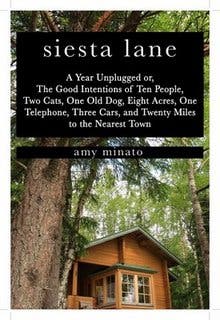 |
| Amy Minato |
Amy Minato is
author of Siesta Lane (creative nonfiction) and the poetry collection
The Wider Lens, and received a 2003 Oregon Literary Arts Fellowship.
Amy teaches writing through Literary Arts and Wordstock, and at Breitenbush,
Sitka Center, Opal Creek, and other venues. She and her family migrate between
Portland and the Wallowa Mountains where they lived for five years while Amy was
Education Coordinator at Fishtrap.
 |
| Siesta Lane: One Cabin, No Running Water, and a Year Living Green. |
Amy Minato's contemplative life
By
Jeff Baker, The Oregonian
Amy Minato grew up in Chicago and loved it but wanted to live somewhere simpler and greener. She moved to Eugene, but that wasn't quite simple and green enough.
"But though a hip college town, Eugene is still a city where buildings obscure land," Minato writes in "Siesta Lane: One Cabin, No Running Water, and a Year Living Green." "My soul pinches and pinches at me until I search the classifieds for a way to live more rural ...."
Minato found a place in Rainbow Valley, about 10 miles west of Eugene, off a road called Siesta Lane. It was a cabin with electricity but no water and heat, on eight acres with some other cabins and a main house. Sort of private, sort of communal, and very rustic.
She loved it.
"I felt like stepping out of society and renewing my personal values," she said. "I wanted to live a more healthy lifestyle and create a life that was more grounded."
Minato didn't want to go all the way back to nature, though. She loved camping and backpacking but is a social person who values a sense of community. She found that on Siesta Lane and found while keeping a journal that she was able to develop her writing. "Siesta Lane" includes poems, reflections, anecdotes about the year Minato spent in the cabins and illustrations by Jan Muir.
"It's really a call to live a simpler life," she said. "I wanted to see if I could pull it off. I didn't have any kids and I wasn't on some sort of career path -- I know not everyone can do that -- but it really worked for me."
One benefit of living at a slower pace in a rural setting is learning more about flora and fauna and the rhythms of nature. There are all kinds of birds and animals in the woods of western Lane County and Minato eventually has to face an ethical dilemma: What effect does an intelligent, aggressive cat have on the local bird population?
All good things must come to an end, and life in the cabin on Siesta Lane ended when the property was sold. Minato fell in love and got married and became a poet and writer and teacher and mother. She lives most of the year in Multnomah Village, which she enjoys for its feeling of community within a city, and part of the year in Joseph, at the foot of the Wallowa Mountains.
There are more writing projects planned, more worlds to discover, but only one Siesta Lane.
Amy Minato’s Siesta Lane
by Kent Griswold
(...) A restless city poet recounts her experiment with country living.
The idea to swim against the “consumptive current” and move west came to Minato (The Wider Lens, 2004) during a Chicago traffic jam. Increasingly bothered by the global impact her metropolitan existence was having on the environment, the poet packed up and headed to Oregon for graduate school.

But after eight years, even Eugene proved too urban for her, and she moved again, this time to a ten-square-foot cabin that was part of an eight-acre commune on Siesta Lane in the relative wilds of Rainbow Valley, Ore.
Her memoir, a veritable menagerie of thoughts, observations, photos, poems and lovely pen-and-ink drawings by Jan Muir, is the result of Minato’s year or so away, where she discovered as much about herself as the wonders of nature. “Not so simple—simple living,” she realized early on. Characterizing each of her fellow Siesta Lane residents, the author doesn’t neglect herself, saying she’s a “single woman with ninety-eight part-time jobs trying to figure out how she connects to the greater forces of the universe and to the tiny earwigs that hide in the curled-up seed heads of Queen Anne’s lace.”
Part of this volume’s charm lies in its somewhat fractured composition, which mirrors the author’s state of mind during this transitional period. Short chapters hop from “Incubation” to “Freaks” to “July” to “The Garden,” while loosely conveying the sense oftime’s passage as Minato adjusted to her rustic domestic situation.
Living without many modern conveniences—for example, only the commune’s main building had a kitchen and running water—led her to provocative conclusions: “For us it appears to primarily be the mind that evolves, and we then cater our surroundings to our weakening bodies.” She took some radical actions as well, such as getting rid of her cat after he brought home one too many birds.
An evocative record of a year in the woods and an interesting study in enacting one’s beliefs.
http://tinyhouseblog.com/book-review/amy-minatos-siesta-lane/
http://blog.oregonlive.com/books/2009/03/amy_minatos_contemplative_life.html


 But after eight years, even Eugene proved too urban for her, and she moved again, this time to a ten-square-foot cabin that was part of an eight-acre commune on Siesta Lane in the relative wilds of Rainbow Valley, Ore.
But after eight years, even Eugene proved too urban for her, and she moved again, this time to a ten-square-foot cabin that was part of an eight-acre commune on Siesta Lane in the relative wilds of Rainbow Valley, Ore.
No hay comentarios:
Publicar un comentario